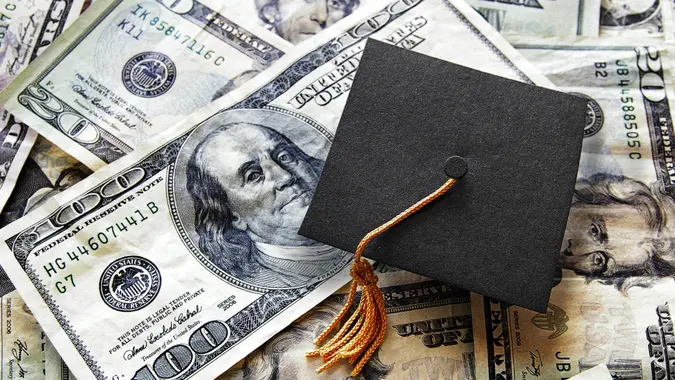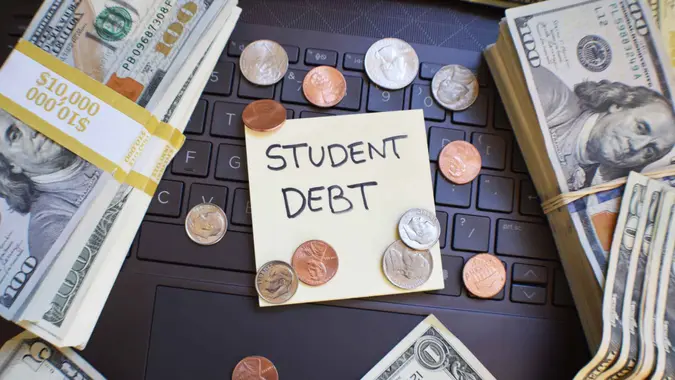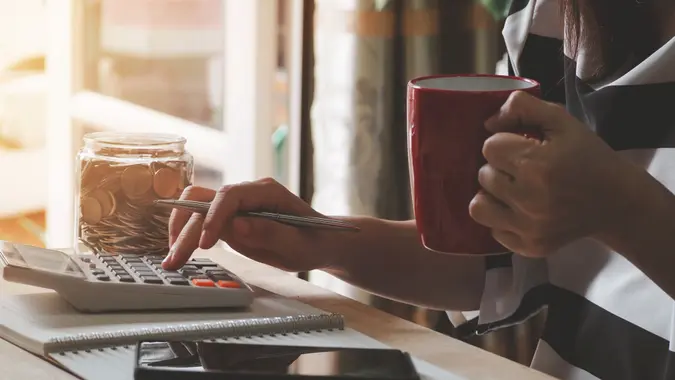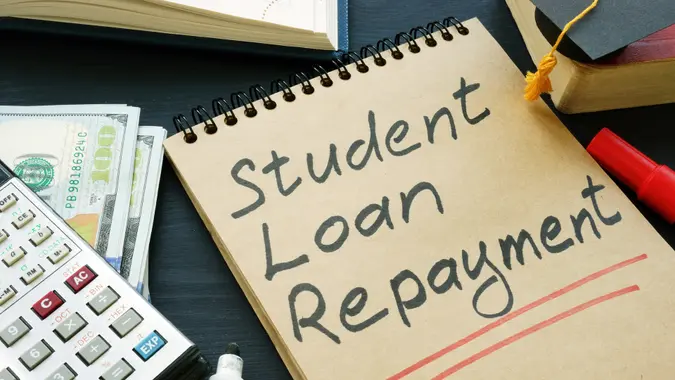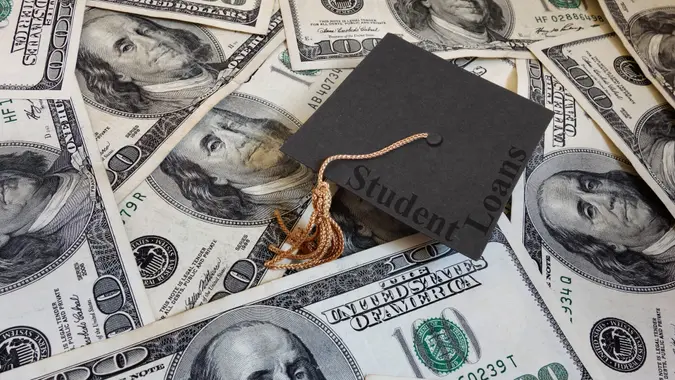What Is Student Loan Default?

Commitment to Our Readers
GOBankingRates' editorial team is committed to bringing you unbiased reviews and information. We use data-driven methodologies to evaluate financial products and services - our reviews and ratings are not influenced by advertisers. You can read more about our editorial guidelines and our products and services review methodology.

20 Years
Helping You Live Richer

Reviewed
by Experts

Trusted by
Millions of Readers
The total federal student debt balance is $1.64 trillion, which jumps to $1.77 trillion if you include private loans, according to BestColleges.com. If you have student loans, you’re likely putting aside a chunk of money each month to pay them off. You should keep paying them off to avoid the serious consequences resulting from defaulting on a loan.
Here’s a look at what it means to default on student loans and what happens when you do. Understand the ramifications of going into student loan default, and figure out a way to pay off your student loans to avoid the negatives that come with defaulting.
What Is a Student Loan Default?
Default means you stop making payments on a loan for a certain period. That period is 270 days for federal student loans, after which you are considered in default. It’s only 120 days for a private student loan.
Failure to pay your loans without negotiating a payment plan can cause serious repercussions; it could negatively impact your credit score and result in wage garnishment.
Federal vs. Private Loan Default
To be considered in default, you would have to fall behind on a federal loan for 270 days, and your wages can be garnished to pay it off. Private lenders only give you 90 to 120 days and can sue you to recover the payments, but must win a judgment before collecting the funds.
Private lenders can help if you are proactive and contact them before you get too close to defaulting. You can negotiate a repayment plan, loan modification or request forbearance.
Other good options are loan rehabilitation and consolidation. These might be best for federal student loans. Monthly rehabilitation payments are equal to 15% of your discretionary income, and you have to make nine monthly loan payments within 10 months. Consolidation is only possible if you make three consecutive on-time payments on the defaulted loan. Then, you can use an income-driven repayment plan for the consolidated loan.
Key Differences Between Federal and Private Loan Defaults
| Feature | Federal Student Loans | Private Student Loans |
|---|---|---|
| Time to default | 270 days (about 9 months) of missed payments | Varies by lender; often 90-120 days |
| Impact on credit score | Significant drop; reported to credit bureaus after delinquency | Immediate negative impact on credit score |
| Collection actions | Wage garnishment, tax refund seizure, Social Security offset | Lawsuits, wage garnishment — if court-ordered |
| Options for recovery | Loan rehabilitation, consolidation, repayment plans | Settlement, refinancing, repayment negotiation |
| Legal consequences | No statute of limitations on collections | Lenders may sue; statute of limitations applies |
| Forgiveness programs | Eligible for forgiveness under some programs | No forgiveness options |
| Ability to pause payments | Deferment, forbearance, income-driven repayment options | Limited or no deferment/forbearance options |
| Who to contact | Federal Student Aid, loan servicers | Private lender or loan servicer |
What Happens if You Default on Student Loans?
The federal student default rate in 2024 is 0% due to COVID-19 policies that are set to expire. However, this default rate will likely rise sharply in 2025. Don’t become a statistic — make your student loan payments a priority, or one or more of these things could happen to you:
- Credit score damage: Your credit score will drop if you stop making student loan payments.
- Wage garnishment: If you default, the government can garnish your wages without a court order and seize your tax refund.
- Possible compromise of employment: Employers who run credit checks as part of the screening process will see that you defaulted on your student loan. Although this might not be a deal breaker for employment, in some industries it can hurt if you’re looking for work in the financial field or applying for positions with the federal government.
- Loss of federal loan benefits: You won’t be eligible for perks like forbearance, deferment and forgiveness if you default on a federal loan.
- Potential legal action: Private lenders can take you to court if you default on their loan. It’s very expensive to go to court, and you’re better off coming to an agreement on a repayment plan with the lender and getting back on track.
How To Know if Your Loans Are in Default
Staying out of default is important for any borrower. These are some of the ways you can monitor the status of your loan balance.
- Visit the Federal Student Aid website: You can check the loan status of your federal student loans through this website.
- Contact your loan service provider: Check in with your private lender to see if your loan is in good standing.
- Review your credit report: If you have defaulted on any of your student loans, it will show up on your credit report as a negative account.
How To Recover from Default
Borrowers have several ways to get back on track after defaulting on a student loan. These are some of your options.
Loan Rehabilitation
If you default on a loan, you can bring it back to good standing with nine monthly payments over 10 months. These payments are based on 15% of your discretionary income. The federal government will remove the default status from your credit report. You’ll return to making monthly payments while having access to federal benefits, such as deferment and forbearance.
Loan Consolidation
Borrowers can consolidate their federal student loans into a Direct Consolidation Loan to get out of default and return to making monthly payments. You can stretch out the consolidation loan to reduce your monthly payments and make the debt more manageable.
Private lenders also let you consolidate your loan balances. You can group them all under the same umbrella and make lower monthly payments if you add more years to your loan. However, this consolidation approach will keep you in debt longer and increase how much interest you’d owe.
Debt Settlement
If you cannot pay off the loan or get back on track, you can agree to a debt settlement. During this process, you can negotiate paying off your debt for less than the amount you owe. Some lenders may reason that it is better to get something instead of nothing, and they may let low-income borrowers take this route. However, debt settlement is not a guarantee.
How To Avoid Default
Avoiding a default comes down to following the basics. Borrowers should set budgets and remove any unnecessary expenses and subscriptions from their credit cards. While that’s a good starting point, you can also set up automatic payments and explore income-driven repayment plans for your student loans. As a last resort, you can apply for deferment or forbearance before missing payments.
If you want to check the status of your loan, you can review your credit report and see if it has any negative accounts. You can also contact your private lender or visit the Federal Student Aid website to check on the status of a federal loan.
If You Default on Your Student Loan
If you do default on your federal student loans, take action immediately so it doesn’t impact your credit score. Restructure your payments, settle the debt or consider requesting a loan forbearance. A student loan forbearance suspends your payments for a short period so you can reorganize your finances and figure out how to pay them.
If you’re in default, there are ways to get out of it. Consider these five options:
- Repayment in full: You promise to repay your student loan in full by setting up a new payment plan.
- Loan rehabilitation: You agree to meet certain requirements in writing, including making payments equal to 15% of your discretionary income.
- Loan consolidation: If you have multiple student loans with different interest rates, you might be eligible for a Direct Consolidation Loan, which features a fixed interest rate that will likely make your payments more affordable. You can apply directly through the U.S. Department of Education’s Federal Student Aid website.
- Loan forgiveness: You might be able to get out of paying student loans if you experienced issues at the school or if you work in a public service job for 10 years while making regular payments. To discharge your debt, you must apply for a loan cancellation with the government.
- Settlement: You can settle student loan debts. If you go this route, consider working with a lawyer or tax professional to uncover all the tax implications. Lenders typically ask you to pay a large lump sum for a settlement, but you can sometimes negotiate a lower amount.
Whether you have Navient, Wells Fargo, private student loans or others, read your loan agreement for details about default consequences. Your loan provider might outline ways to set up a repayment plan and provide resources to help you avoid default.
Sabah Karimi contributed to the reporting for this article.
Our in-house research team and on-site financial experts work together to create content that’s accurate, impartial, and up to date. We fact-check every single statistic, quote and fact using trusted primary resources to make sure the information we provide is correct. You can learn more about GOBankingRates’ processes and standards in our editorial policy.
- BestColleges. 2025. "Average Student Loan Debt in 2025."
- Education Data Initiative. 2025. "Student Loan Debt Statistics."
- The Pew Charitable Trusts. 2023. "At What Cost? The Impact of Student Loan Default on Borrowers."
- Consumer Financial Protection Bureau. "What happens if I default on a federal student loan?"
- FederalStudentAid. "What are the consequences of default?"
 Written by
Written by  Edited by
Edited by 



